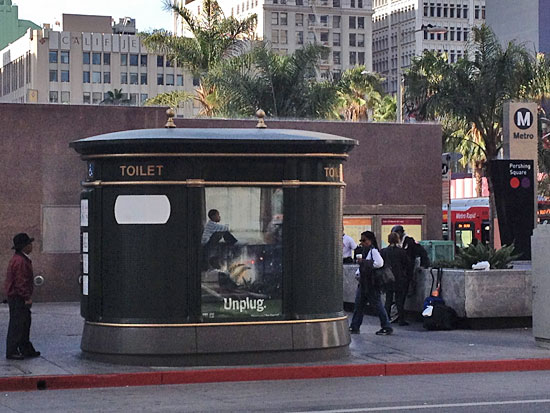Metro’s hardest seat to get
February 13, 2014

Despite a city-owned public toilet, Metro gets complaints of public urination at Pershing Square station.
As the saying goes, “When you gotta go, you gotta go.” That’s true whether you’re in a restaurant, a concert hall or riding a subway. But, despite public demand, installing restrooms at Metro stations is no easy business, according to the transportation agency, which recently undertook a study of the issue.
“We want to ensure that our customers have a great riding experience and have resources when a need arises, but there are a lot of elements that have to be factored in,” says Debra Johnson, Metro’s interim chief operating officer.
Although the agency has been grappling with the issue of public restrooms for years, Metro’s Board of Directors ordered a new look in November after residents near the Pierce College Station of the Orange Line busway in the San Fernando Valley complained that some riders were urinating in public. Among other things, Metro installed a video camera and monitored the area for 30 days, but couldn’t corroborate those complaints.
At the same time, the agency also was asked to take a look at the potential need for publicly-accessible restrooms at subway, light rail and bus rapid transit line stations throughout the system. The bottom line, according to a report that will be presented to the board later this month: Increasing the number of restrooms would not only be costly but could create crime problems unless security is enhanced at each location.
Currently, Metro maintains public toilet facilities at Union Station, the El Monte Bus Terminal and the Harbor/Gateway Transit Center—transportation “hubs” where staffers are present at all times. According to employee observations, restrooms in the busy Union Station were used consistently throughout the day. At the El Monte facility, five or fewer customers lined up during peak hours to use the free-standing automated public toilet, with less use at the Harbor/Gateway center.
The report notes that Metro employee restrooms are in place at Red Line subway stations but are opened to the public only in emergencies, as determined by Metro personnel. Generally, the report said, “customers are informed no public toilets are available,” even though it’s not uncommon for Red Line riders at the large 7th Street station to ask about the availability of public restrooms.
The agency, in its report, acknowledged the unpleasant realities that confront customers at some stations.
“Metro’s custodial staff report on-going issues with public urination and defecation at several of the rail stations as well as inside many of the station elevators,” the report said, adding that “other areas of public urination include the top side of subway station entrances such as Pershing Square, where loitering is common.”
But the agency pointed to the complexities of opening new restrooms with a cautionary tale of what happened when The W Hotel, located above the Hollywood and Vine Red Line station, agreed to provide a street-level public toilet as part of their contract with Metro.
According to Metro, the facility “became a magnet for the area’s homeless population which impacted the use by Metro’s customers. While open, the hotel developer was expending an average of $250 per day on paper products and had to replace three sinks, three mirrors and five toilet seats due to damage.” The restroom was labeled a public nuisance and was shuttered less than 4 months after its opening.
Johnson, Metro’s interim operations chief, notes that these kinds of problems are not limited to Metro operations. “It’s something that plagues us in today’s society considering the amount of people who don’t have access to facilities,” she said. “You could be walking around a city street and step around a puddle of urine. Collectively, I think there is an issue that needs to be addressed holistically.”
There’s also the price to consider. According to her department’s report, individual hard-wall toilets cost up to $700,000 to install and require regular stocking, maintenance and cleaning. In December, Robin Blair, the agency’s planning director, estimated that it would cost $70 million annually to maintain restrooms at every station. The agency estimates that the free-standing automatic public toilets would cost about $600,000 for two units, plus considerable custodial costs.
Then there are the public safety issues that come with adding restrooms to the system, thus creating a venue for illegal activity. “If you go anywhere in the world where people have tried this,” Blair said, “all of your problems are in the restrooms—crime, muggings, shooting up—all sorts of human degradation.”
“It’s up to the Board [of Directors] to decide what direction to take,” Johnson said. “For staff, our first and foremost mission is to ensure a safe environment for the riding public.”
No rider, of course, would argue with that goal. But a good number of them, like Renee Briddle, 38, who commutes 2 hours from Long Beach through downtown Los Angeles on the Blue and Red lines, think the status quo stinks.
Briddle was standing next to a small pool of urine the other day in a Civic Center station elevator. “It smells like that all the time,” she said, adding that such conditions are not uncommon, as Metro itself admits. One time, Briddle confided, she herself had an accident during one of her long commutes. “We need bathrooms,” she said, before hurrying on her way.
Posted 2/13/14












 405 bridge work causes a stink
405 bridge work causes a stink

